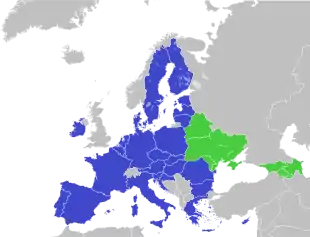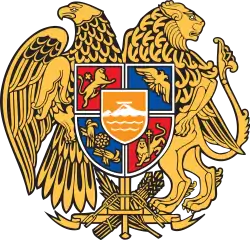Armenia-EU Comprehensive and Enhanced Partnership Agreement
The Armenia-EU Comprehensive and Enhanced Partnership Agreement or CEPA is an agreement covering issues of EU interests, including cooperation in economic, trade and political areas between the European Union and Armenia. The agreement develops these areas further, providing a long-term basis for further integrating and strengthening EU-Armenia relations. The agreement is also designed to bring Armenian law gradually closer to the EU acquis.
Long name:
| |
|---|---|
 Map of Europe with the European Union in green and Armenia in orange. | |
| Type | Comprehensive and Enhanced Partnership Agreement |
| Context | Framework for cooperation between the EU and a non-EU country |
| Signed | November 24, 2017[1] |
| Location | |
| Effective | November 24, 2017 |
| Condition | Ratification by all signatories |
| Signatories | (and the -then- 28 EU member states) |
| Ratifiers | 31 / 31
|
| Depositary | General Secretariat of the Council of the European Union |
| Languages | All 24 official Languages of the European Union and Armenian |
Background
Armenia's relations with the EU had previously been governed by the Partnership and Cooperation Agreement (PCA) (signed in 1996 and in force since 1999), which served as the legal framework for EU-Armenia bilateral relations. Armenia and the EU began negotiating a new and more complex Association Agreement, which had included a Deep and Comprehensive Free Trade Area agreement, to replace the old PCA in July 2010.[2] Negotiations were finalized in July 2013 and Armenia (along with Georgia, Moldova and Ukraine) was set to sign the new Association Agreement with the EU during the Eastern Partnership summit in November 2013. However, the government of Armenia, led by former President Serzh Sargsyan had suddenly broke off negotiations to pursue membership in the Russian-led Eurasian Union.[3][4] Other political parties in Armenia criticized the governments last-minute decision to cancel the Association Agreement with the EU and vocally opposed Armenia's membership in the Eurasian Union. Many criticized Russia for pressuring President Sargsyan to abandon the deal with the EU.[5]
Following a period of brief uncertainty between Armenia and the EU, bilateral negotiations resumed on restructuring the relationship.[6] In January 2015 the EU commissioner for European Neighbourhood Policy and Enlargement, Johannes Hahn stated that the EU was willing to sign a revised Association Agreement with Armenia, but that any new deal would exclude a free trade agreement as that would contradict Armenia's membership in the Eurasian Customs Union.[7] Renewed negotiations were launched in December 2015.[8] After extensive negotiations, Armenia and the EU finalized the Comprehensive and Enhanced Partnership Agreement during a ceremony in Brussels.[9] The new Comprehensive and Enhanced Partnership Agreement will expand and broaden the scope of relations between the EU and Armenia.[10] It was signed by Armenia and all EU member states on 24 November 2017.[11][12] The agreement was fully ratified by all 31 parties on 25 January 2021.
What is CEPA

The agreement constitutes an important step towards the increased political and economic involvement of the European Union in the South Caucasus. The scope of the new agreement is comprehensive and covers a wide range of cooperation in economic, trade and political areas. The agreement develops these areas further; providing a long-term basis for further deepening EU-Armenia relations. By intensifying political dialogue and improving cooperation in a broad range of areas, the agreement lays the foundations for more effective bilateral engagement with Armenia.[13] Furthermore, the agreement seeks to foster result-oriented and practical cooperation between all parties for achieving peace, security and stability on the European continent.
Supposed benefits of CEPA
The agreement includes the EU's standard political clauses on human rights, the international criminal courts, weapons of mass destruction, small arms and light weapons, and counter-terrorism. It also contains provisions on cooperation in areas such as transport, energy, health, the environment, climate change, taxation, education and culture, employment and social affairs, banking and insurance, media freedom, minority rights, industrial policy, agriculture and rural development, tourism, research and innovation, and mining. In addition, it covers legal cooperation, the rule of law, democratic reform, combating money laundering and terrorist financing, and fighting organised crime and corruption.[14][15]
The agreement also contains a substantive trade title with important commitments in several trade policy areas. These will improve conditions for bilateral EU-Armenia trade, while taking full account of Armenia's obligations as a member of the Eurasian Union. They will ensure a better regulatory environment for economic operators in areas such as trade in services and goods, setting up and running companies, capital movements, government procurement and intellectual property rights, sustainable development, and competition. The agreement encourages Armenian companies to sell more goods and services to the EU and EU companies to open subsidiaries in Armenia, which will contribute to economic growth and job creation.[14][16] The Comprehensive and Enhanced Partnership Agreement can be seen as a “lite” version of an EU Free Trade Agreement, in which 96% of Armenian goods may enter the EU's single market with zero tariffs. As of 2020, the EU is Armenia's biggest export market.[17]
The agreement also supports enhancing mobility between citizens of the EU and Armenia, while reconfirming the opening of negotiations on visa-free travel for Armenian citizens to the Schengen Area.
Since the signing of CEPA, Armenia is also under negotiations to join the European Common Aviation Area. The agreement will establish a Common Aviation Area between the EU and Armenia which will remove market restrictions and associate Armenia to the EU internal aviation market by harmonizing its aviation legislation with EU standards and implementing a large part of EU aviation rules.[18]
Ratification
In order for CEPA to enter into force, all member states of the European Union, the EU itself, and the European Atomic Energy Community (EAEC) must ratify the agreement. As of 25 January 2021, all 31 parties have fully ratified CEPA.[1] This includes:
Developments
EU membership perspective
According to the Eastern Partnership policy, Armenia can become a member of the European Union.[19] A 2020 poll found that over 40% of Armenians were in favor of EU membership.[20] There are several political parties in Armenia which are opposed to Armenia's current membership in the Eurasian Union. Bright Armenia, the Free Democrats, Heritage, the European Party of Armenia, and the Republic Party each support Armenia's withdrawal from the Eurasian Union and wish to renegotiate a full Association Agreement with a Deep and Comprehensive Free Trade Area between the EU and Armenia.[21] Several political parties also support Armenia's eventual EU membership bid and have campaigned to begin EU accession negotiations.
In October 2019, the Deputy Prime Minister of Armenia Tigran Avinyan stated that Armenia and the EU have a completely different level of relationship following the 2018 Armenian revolution. The Minister confirmed that the revolution strengthened ties between Armenia and the EU as both share the same democratic values. The Minister further stated that, "This new political situation is completely in line with the EU’s views". Avinyan also made clear that in the future, Armenia will have to decide whether or not to pursue an EU membership bid. The Minister advised that any decision for Armenia to join the European Union would have to be brought before the people and that future accession of Armenia to the EU would only occur following Armenia's complete withdrawal from the Eurasian Union.[22]

In December 2019, following the eighth Euronest Parliamentary Assembly, a resolution was passed by all members outlining various EU integration goals to be achieved by 2030. The resolution affirms that the process of EU enlargement is open to Eastern Partnership member states and that future enlargement of the EU will be mutually beneficial for both the EU and Eastern Partnership members. The resolution praised the progress made in Armenia following the 2018 Armenian revolution. The resolution also stated that, "Armenia is the only country in Europe to transition from being a hybrid regime in 2017 to a democracy in 2018" and that the ratification of the Comprehensive and Enhanced Partnership Agreement by the Armenian Parliament in April 2018 is considered evidence of a strategically reinforced partnership between Armenia and EU.[23]
In June 2020, the Chair of the European Parliament stated, "We believe that the successful implementation of the comprehensive reforms by Armenia, in areas such as the rule of law, justice and fight against corruption, will create new incentives for an ambitious path towards European integration and the next steps to be taken by Armenia and the EU in the next decade".[24] Meanwhile, the Ministry of Foreign Affairs of Armenia confirmed that the development of the partnership with the European Union is one of the most important directions of foreign policy of the Republic of Armenia.[25]
See also
References
- "Agreement". www.consilium.europa.eu.
- "Armenia". European External Action Service. Retrieved 11 August 2020.
- "Armenia: Balancing Act Between Russia and Europe". Euractiv. Euractiv News Agency. 11 August 2020. Retrieved 11 August 2020.
- "Paradox of power: Russia, Armenia, and Europe after the Velvet Revolution" – via www.ecfr.eu.
- "New Opportunities in Armenian-EU Relations". PONARS. PONARS Eurasia. Retrieved 11 August 2020.
- "EU Commissioner Opens Door To Armenian Association Agreement". Radio Free Europe/Radio Liberty. 11 August 2020. Retrieved 11 August 2020.
- "EU and Armenia to start negotiations for a new agreement". European External Action Service. 2015-12-07. Retrieved 11 August 2020.
- "Armenia-EU finalize new deal". Asbarez. Asbarez News Agency. 11 August 2020. Retrieved 11 August 2020.
- "EU, Armenia Finalize New Deal on Closer Ties". 11 August 2020.
- "Polish Envoy Expects New EU-Armenia Deal With 'Fingers Crossed'". 2017-07-05. Retrieved 11 August 2020.
- "Agreement details". Council of the European Union. Retrieved 13 January 2015.
- "EU-Armenia Comprehensive and Enhanced Partnership Agreement (CEPA) signed". Action against economic crime and corruption.
- "EUR-Lex - 52017JC0037 - EN - EUR-Lex". eur-lex.europa.eu.
- "EU and Armenia take stock on Comprehensive and Enhanced Partnership Agreement implementation | EU Neighbours". www.euneighbours.eu.
- "New agreement between the EU and Armenia". swedenabroad.se.
- "Armenia - Trade - European Commission". ec.europa.eu.
- "International aviation: Armenia".
- Andrew Rettman (22 October 2010). "EUobserver / EU unlikely to expand into post-Soviet east in next decade". Euobserver.com. Retrieved 7 January 2011.
- "EUSUPP: Support of country's membership in EU (%)". caucasusbarometer.org. Caucasus Research Resource Centers. March 15, 2020. Archived from the original on 14 August 2020.
- "'Armenia must withdraw from EaEU:' "Free Democrats" campaign kicks off from Arabkir | www.aravot-en.am".
- "Armenia's EU accession could be a 'question for the people,' Deputy PM says". euractiv.com.
- "The future of the Trio Plus Strategy 2030: building a future of Eastern Partnership" (PDF).
- "EU salutes Armenia's progress in the sphere of justice".
- "Bilateral Relations: European Union".


